Establish defaults and preferences for Sales Order processing
Orders tab

 Separate orders by division - if using Divisional accounting, to display orders assigned to the Division the User is currently logged into (see General Ledger - Divisions)
Separate orders by division - if using Divisional accounting, to display orders assigned to the Division the User is currently logged into (see General Ledger - Divisions)- Salesperson / Territory Codes
-
 Require salesperson on orders will not allow a Sales Order to be saved unless a Salesperson has been identified
Require salesperson on orders will not allow a Sales Order to be saved unless a Salesperson has been identified -
 Require territory on orders will not allow a Sales Order to be saved unless a Territory has been identified
Require territory on orders will not allow a Sales Order to be saved unless a Territory has been identified
-
- Inventory
 Match lowest price in price matrix - makes sure that if there are multiple discounts on an item in a Sales Order that the system will not go lower than the lowest price recorded in the Price Matrix module ie: Price for Warehouse X + Part Number X + Customer X is $20.00 but price for Produce Code X + Customer Type X is $19.00
Match lowest price in price matrix - makes sure that if there are multiple discounts on an item in a Sales Order that the system will not go lower than the lowest price recorded in the Price Matrix module ie: Price for Warehouse X + Part Number X + Customer X is $20.00 but price for Produce Code X + Customer Type X is $19.00 Use Customer’s default warehouse - if a Warehouse is established in Customer Details > Addresses tab > Order Defaults subtab, this will auto-fill into new Sales Orders, but can be changed at the time of entry
Use Customer’s default warehouse - if a Warehouse is established in Customer Details > Addresses tab > Order Defaults subtab, this will auto-fill into new Sales Orders, but can be changed at the time of entry Use cost from inventory for non-physical items - will post a value into Cost of Goods Sold and deplete Inventory value for the amount of the cost
Use cost from inventory for non-physical items - will post a value into Cost of Goods Sold and deplete Inventory value for the amount of the cost Always ship - will disable order and backorder quantity fields in the Sales Order
Always ship - will disable order and backorder quantity fields in the Sales Order
- Required Date will automatically fill in the Required Date on a new Sales Order based on settings established here:
- activate -
 Set default required date
Set default required date - set the default number of Days before an order is required
- activate -
- Set default quote expiry - activate and identify default # of days from Order Date that the Quote will expire, which will load into new Sales Orders:

- Prices
-
 Warn on zero price invokes a popup message when price is not present in a Sales Order
Warn on zero price invokes a popup message when price is not present in a Sales Order -
 Automatically update customer price table - if a price is entered on a Sales Order where there is a price in the Price Matrix module for the Inventory item and Customer, and the price is different than the Price Matrix price, the system will update the Price Matrix price with this new one
Automatically update customer price table - if a price is entered on a Sales Order where there is a price in the Price Matrix module for the Inventory item and Customer, and the price is different than the Price Matrix price, the system will update the Price Matrix price with this new one -
 Create records for shipping address only - update Price Matrix on above scenario for shipping address only
Create records for shipping address only - update Price Matrix on above scenario for shipping address only
-
 Use Incoterms (International Commercial Terms) to enable a selection list in your Sales Orders instead of FOB (Free On Board):
Use Incoterms (International Commercial Terms) to enable a selection list in your Sales Orders instead of FOB (Free On Board):
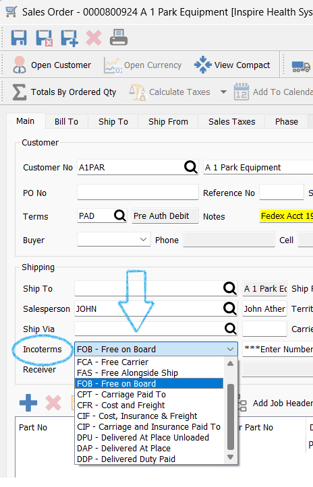
Process/Invoicing tab
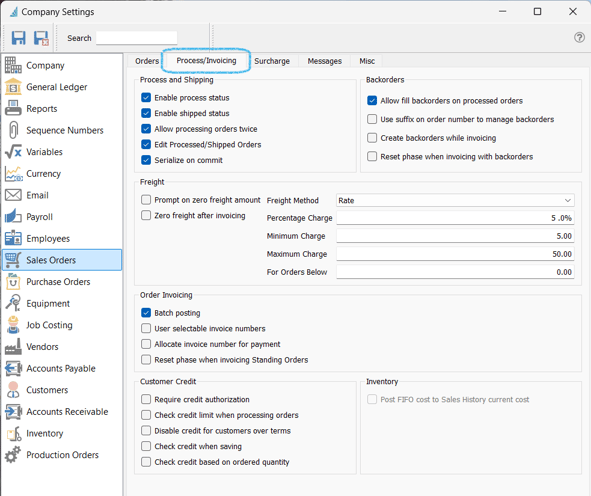
- Process and Shipping
 Enable process status - activates the
Enable process status - activates the  Process icon to assign Sales Orders a Process status
Process icon to assign Sales Orders a Process status
-
 Enable shipped status - activates the
Enable shipped status - activates the  Ship icon to assign Sales Orders a Shipped status
Ship icon to assign Sales Orders a Shipped status Allow processing orders twice - once a Sales Order is put into Process status, this setting enables the Reprocess button to allow Process reports to be re-printed (Process-Pick Slip / Packing Slip)
Allow processing orders twice - once a Sales Order is put into Process status, this setting enables the Reprocess button to allow Process reports to be re-printed (Process-Pick Slip / Packing Slip) Edit Processed/Shipped orders - if using the Process or Ship status options
Edit Processed/Shipped orders - if using the Process or Ship status options Serialize on commit to prompt for serial number selection once a serialized item is committed on a Sales Order or Production Orde
Serialize on commit to prompt for serial number selection once a serialized item is committed on a Sales Order or Production Orde
- Backorders
-
 Allow Fill Backorders on processed orders
Allow Fill Backorders on processed orders -
 Use suffix on order number to manage backorders - the original invoice number will be appended with a number ie: original invoice number 80075 / backorder invoice number will be 80075-0 / subsequent backorders on this order will be 80075-1 / 80075-2, etc
Use suffix on order number to manage backorders - the original invoice number will be appended with a number ie: original invoice number 80075 / backorder invoice number will be 80075-0 / subsequent backorders on this order will be 80075-1 / 80075-2, etc -
 Create backorders while invoicing - will create a new order with a new number
Create backorders while invoicing - will create a new order with a new number -
 Reset phase when invoicing with backorders - if using Phases (see Sales Orders - Phases), the phase will be set back to nothing when there is a backorder
Reset phase when invoicing with backorders - if using Phases (see Sales Orders - Phases), the phase will be set back to nothing when there is a backorder
-
- Freight - establish default settings for Shipping methods setup in Edit > Ship Via
-
 Prompt on zero freight amount - if freight is missing on a Sales Order, a message will pop
Prompt on zero freight amount - if freight is missing on a Sales Order, a message will pop  Zero freight after invoicing - if automated freight charges settings have been established here, and a partial shipment is sent, then the charges will not calculate on backorders
Zero freight after invoicing - if automated freight charges settings have been established here, and a partial shipment is sent, then the charges will not calculate on backorders- Freight Method for Freight charges
- Prompt leaves Freight field open for input
- Fixed applies the same rate value on all Sales Orders
- Rate allows input of Percentage Charge
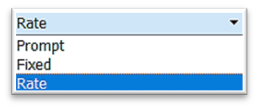
- Percentage Charge - percentage of the Sales Order value that will be put into Freight
- Minimum Charge - what the minimum amount of Freight will be on any Sales Order, regardless of Percentage calculation
- Maximum Charge - what the maximum amount of Freight will be on any Sales order, regardless of Percentage calculation
- For Orders Below - option to assign the minimum Sales Order value that these limitations will apply to
-
- Order Invoicing
 Batch Posting assigns the Invoice No to the Sales Orders and gathers transactions into a batch for review before posting to AR and GL
Batch Posting assigns the Invoice No to the Sales Orders and gathers transactions into a batch for review before posting to AR and GL User selectable invoice numbers - leaves the Invoice Number field open in a Sales Order for user input before invoicing the order
User selectable invoice numbers - leaves the Invoice Number field open in a Sales Order for user input before invoicing the order Allocate invoice number for payment - if a sales order does not yet have an associated invoice number, enable this setting to use the next invoice number from Company Settings > Sequence Numbers when the invoice payment screen is opened, prior to posting the invoice. This is useful if the invoice number needs to be known at the time the payment is taken.
Allocate invoice number for payment - if a sales order does not yet have an associated invoice number, enable this setting to use the next invoice number from Company Settings > Sequence Numbers when the invoice payment screen is opened, prior to posting the invoice. This is useful if the invoice number needs to be known at the time the payment is taken. Reset phase when invoicing Standing Orders - if using Phases (see Sales Orders - Standing), the phase will be set back to nothing whenever the Standing Order is invoiced
Reset phase when invoicing Standing Orders - if using Phases (see Sales Orders - Standing), the phase will be set back to nothing whenever the Standing Order is invoiced
- Customer Credit
 Require credit authorization - where a Sales Order is being invoiced that will put the Customer over their pre-established Credit Limit, a Credit Failure message will pop up, where only a user with the right access can override the message and allow processing of the Sales Order to proceed
Require credit authorization - where a Sales Order is being invoiced that will put the Customer over their pre-established Credit Limit, a Credit Failure message will pop up, where only a user with the right access can override the message and allow processing of the Sales Order to proceed Check credit limit when processing orders - as opposed to when invoicing them
Check credit limit when processing orders - as opposed to when invoicing them Disable credit for customers over terms - Sales Orders cannot be saved in this scenario
Disable credit for customers over terms - Sales Orders cannot be saved in this scenario Check credit when saving - as opposed to only when entering
Check credit when saving - as opposed to only when entering Check credit based on ordered quantity - as opposed to shipped quantity
Check credit based on ordered quantity - as opposed to shipped quantity
- Inventory
 Post FIFO Cost to Sales History Current Cost - if Inventory Costing Method is set to FIFO, the system will track the average cost and the FIFO cost for Sales History reports
Post FIFO Cost to Sales History Current Cost - if Inventory Costing Method is set to FIFO, the system will track the average cost and the FIFO cost for Sales History reports
Surcharge tab - if you are using a surcharge on invoices

- establish Min / Max allowed on any one invoice
- select the GL account the value will be accumulated in
- give the Surcharge an Alias, or how it will appear on Customer invoices
Messages tab
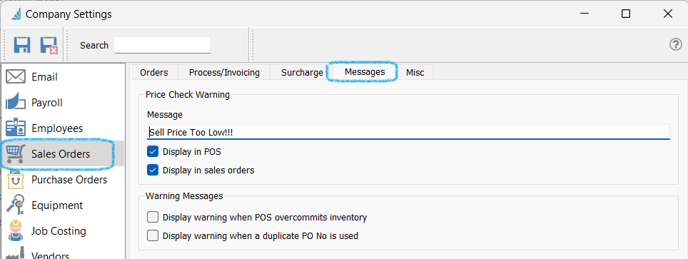
- Price Check Warning Message - establish the message that will display if a selling price is entered into a Sale Order and the margin turns out to be lower than the margin established in the related Product Code or Price Matrix setting
-
 select where you want this popup message to display
select where you want this popup message to display
-
-
Warning Messages
-
 Display warning when POS overcommits inventory - if the Point of Sale operator enters a quantity on an item that doesn’t have enough in stock, a warning message will pop up
Display warning when POS overcommits inventory - if the Point of Sale operator enters a quantity on an item that doesn’t have enough in stock, a warning message will pop up
-
-
-
 Display warning when a duplicate Purchase Order number is used (for any one Customer)
Display warning when a duplicate Purchase Order number is used (for any one Customer)
-
Misc tab
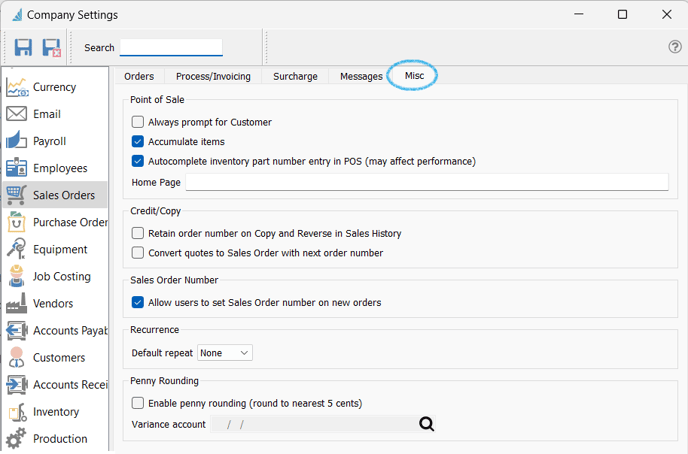
- Point of Sale
-
 Always prompt for customer - if this is unchecked, the user is allowed to not enter a Customer on an order, whereby the system will auto-create a Customer record using the numbering sequence established in Company Settings > Sequence Numbers > Customer
Always prompt for customer - if this is unchecked, the user is allowed to not enter a Customer on an order, whereby the system will auto-create a Customer record using the numbering sequence established in Company Settings > Sequence Numbers > Customer -
 Accumulate Items - if an item is scanned or entered more than once onto an order, the system will just increase the quantity of the first instance
Accumulate Items - if an item is scanned or entered more than once onto an order, the system will just increase the quantity of the first instance  Autocomplete Inventory part number entry in POS for quicker search / entry but potentially slower processing all around
Autocomplete Inventory part number entry in POS for quicker search / entry but potentially slower processing all around- Home Page - establish the POS screen display, which can be a website, or a series of item images (items on sale for example) or a sale flyer image, etc.

-
- Credit / Copy
-
 Retain Order number on Copy and Credit in Sales History - when creating a new or credit order from an invoice in Sales History, Spire will use the same order number
Retain Order number on Copy and Credit in Sales History - when creating a new or credit order from an invoice in Sales History, Spire will use the same order number -
 Convert Quote to Sales Order with next Order number - instead of maintaining the order number that starts with a ‘Q’, once the Quote is changed to ‘Open Sales Order’, the system will re-assign the Order number, using the one next available
Convert Quote to Sales Order with next Order number - instead of maintaining the order number that starts with a ‘Q’, once the Quote is changed to ‘Open Sales Order’, the system will re-assign the Order number, using the one next available
-
- Sales Order Number
-
 Allow users to set Sales Order number on new orders - leaves the Order Number field accessible for users to enter their own number
Allow users to set Sales Order number on new orders - leaves the Order Number field accessible for users to enter their own number
-
- Recurrence
- Default Repeat - choose from Daily / Weekly / Monthly / Yearly for the default recurrence on a Standing Order (this can be changed at the time of Order entry)
- Penny Rounding - activate for cash sales
 Enable penny rounding (round to nearest 5 cents)
Enable penny rounding (round to nearest 5 cents)- establish the Variance GL account that this variance will be captured in
.png?height=120&name=Gemini-Logic-Logo%20(1).png)
